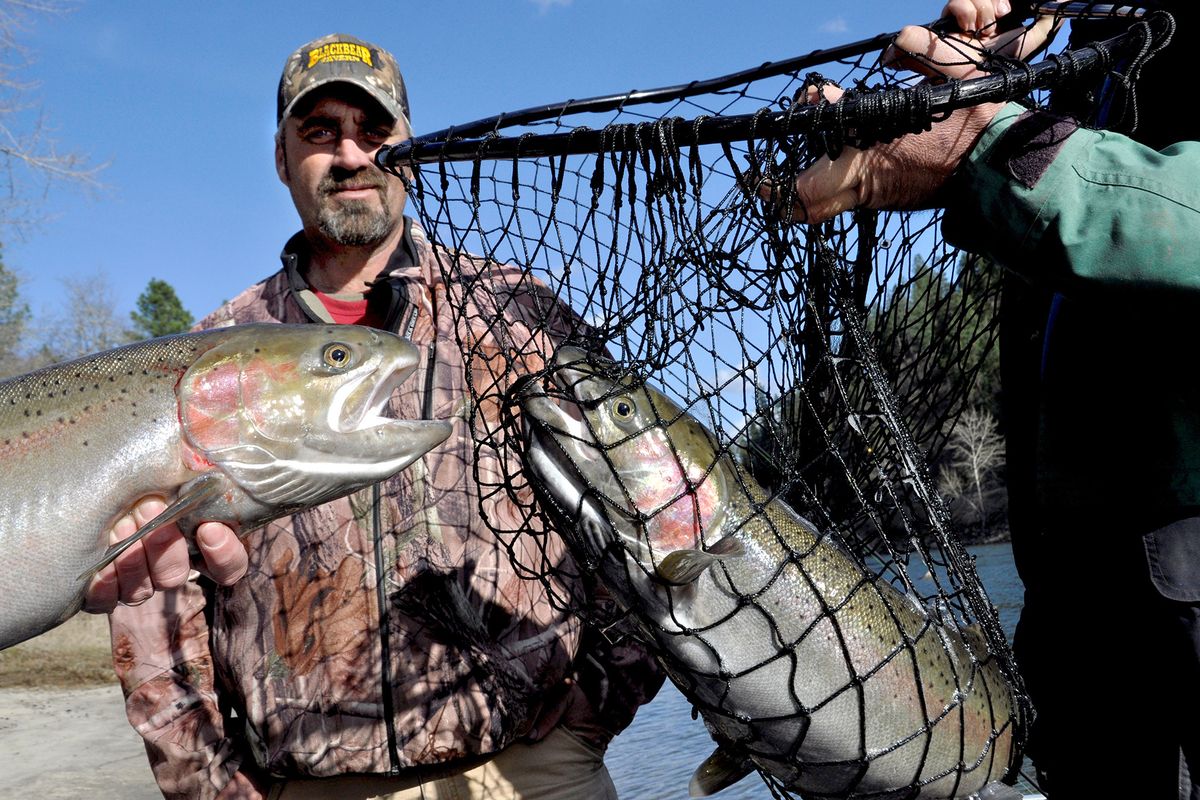Landers: Fishing guide Jim McCarthy leads clients into fray of B-run steelhead

“My biggest day was three anglers with 60 fish,” Idaho guide Jim McCarthy said last week.
The number 60 is more typically equated with, say, jigging for 10-inch panfish, or a good start on the Biblical miracle of loaves and fishes.
But McCarthy was describing the mid-February 2015 madhouse of fishing for steelhead – the big 28- to 40-inch ocean-going bruisers that return to the Clearwater River.
Just one of these fish can make an angler’s day, so it’s no surprise that word got out quickly. Fishing on the Clearwater, especially in the Orofino area, was on fire.
“It didn’t hurt that the midday temperatures were in the 50s,” he said. “Everybody suddenly got spring fever. Some parts of the river were jammed.”
By late last week, the crowd had thinned to pleasant numbers of boats and shore anglers. One of McCarthy’s guests was wearing flip-flops in the boat at 10 a.m.
“At some point we’re going to pay for this winter’s warm weather and no snow,” said Dan Barth of Spokane as he wiggled his toes on the deck of McCarthy’s jet sled. “But I’m enjoying the moment.”
In more ways than one.
Barth hooked a big Clearwater hatchery steelhead within 15 minutes of the boat being launched near Orofino.
Bonk. Good start to the day.
McCarthy has seen all sorts of good days and bad days on the river in more than 30 years of guiding.
“Last year was tough on guides,” he said. “Fish and Game was concerned the Clearwater B-run wasn’t going to be big enough to get the eggs they needed at the hatcheries, so we could keep only fin-clipped steelhead under 28 inches long.
“That didn’t leave many fish to keep since most of the steelhead in the Clearwater are longer than that.”
The term “B run” refers to the later returning, larger Idaho steelhead that spend more time in the ocean than the earlier returning “A run” steelhead. B-run fish return mostly to the Clearwater and Salmon rivers.
After leaving the ocean last summer and wintering somewhere in the Columbia, Snake or Clearwater, these fish are making their last surge toward spring spawning.
With less competition last year, the catch-and-release catch rates were excellent for most of his clients.
This year, the catch rates have generally been high despite the crowd.
“We have plenty of fish,” said McCarthy, a man of few words. “That’s always good.”
McCarthy, who’s been fishing the Clearwater and learning its moods and secrets since childhood, said his grandparents homesteaded up the North Fork Clearwater before the waters were inundated by Dworshak Dam.
His father was a fishing outfitter in the 1980s.
“He was one of the few guides out here at that time,” he said.
“Dad sold his outfitter business so neither my brother nor I could take it over. But I kept guiding anyway.
“I like being on the water,” he said, summing up the reasoning for his career choice.
McCarthy also is a minimalist in rigging for steelhead.
He trolls in some conditions, and he had cured eggs ready to go by his tackle box if needed.
But his clients recently have been catching their fish side drifting with one of the simplest rigs on the river.
From a tri-swivel at the end of his main line, he’s been attaching pencil lead and running about 4 feet of 12-pound monofilament leader to a Size 4 Gamakatsu red hook.
He threads on a single orange-colored foam floating bead (8-10mm) up the leader and stops it 8 inches above the small hook.
That’s it. No bait.
“Smaller the better,” he said. “I like the foam ones because they don’t shine,” noting that a craft story can be as important to anglers nowadays as a tackle shop.
McCarthy plans to continue fishing for Clearwater steelhead as long as they’re in good condition.
“That’s mid- to late-March, depending on the year,” he said. “Fish headed for the Clearwater are still trickling over Ice Harbor Dam (on the Snake).
“October fish are fresher, and they fight better in the lower warmer water,” he said. “But I like late winter. There’s a lot of fish, the weather is warming up and – usually – there are fewer people.”
A fishing guide in the Clearwater region never has much time to get out of fishing shape.
Next up the river are spring chinook, reputed to be the most delicious of the salmonids returning to the Columbia system each year.
“I’ll be getting ready for them in April,” he said. “You never know with the low snowpack what the river will do and when the fish will move.”
He said nobody he knows along the Clearwater would plan a wedding around May 10.
They might even postpone birthdays – or funerals.
“You want to be ready to catch a salmon.”